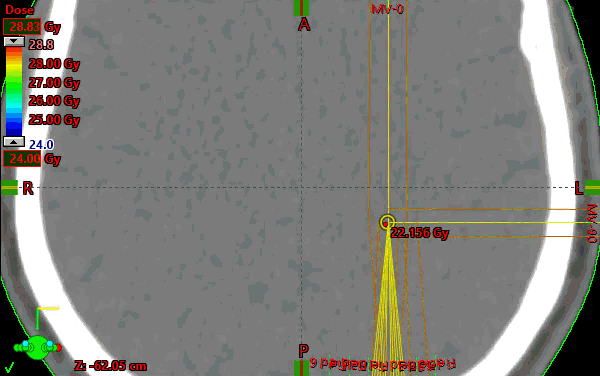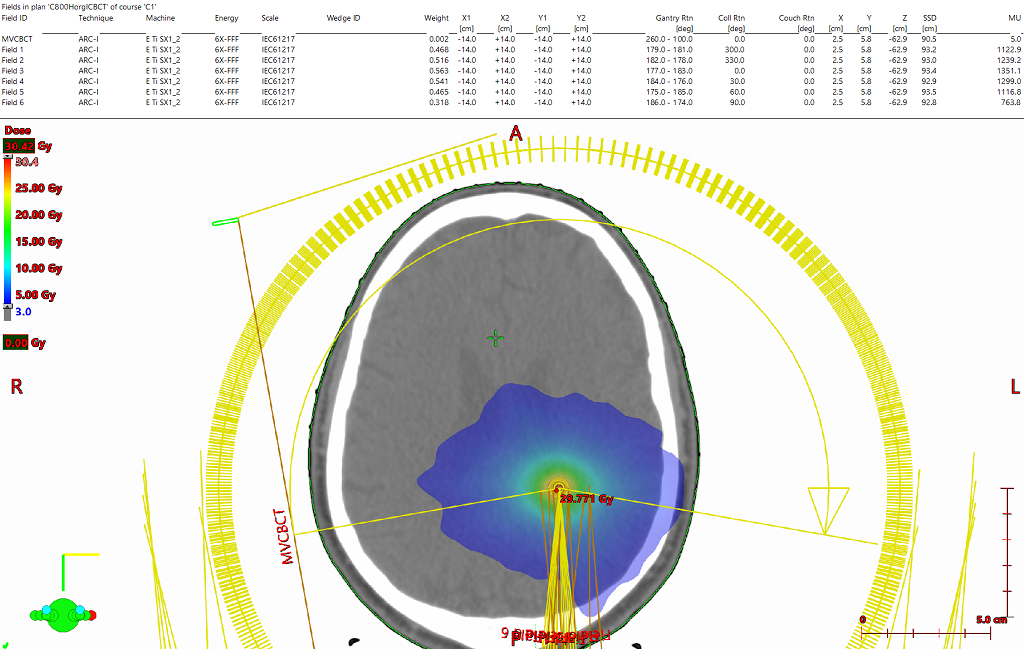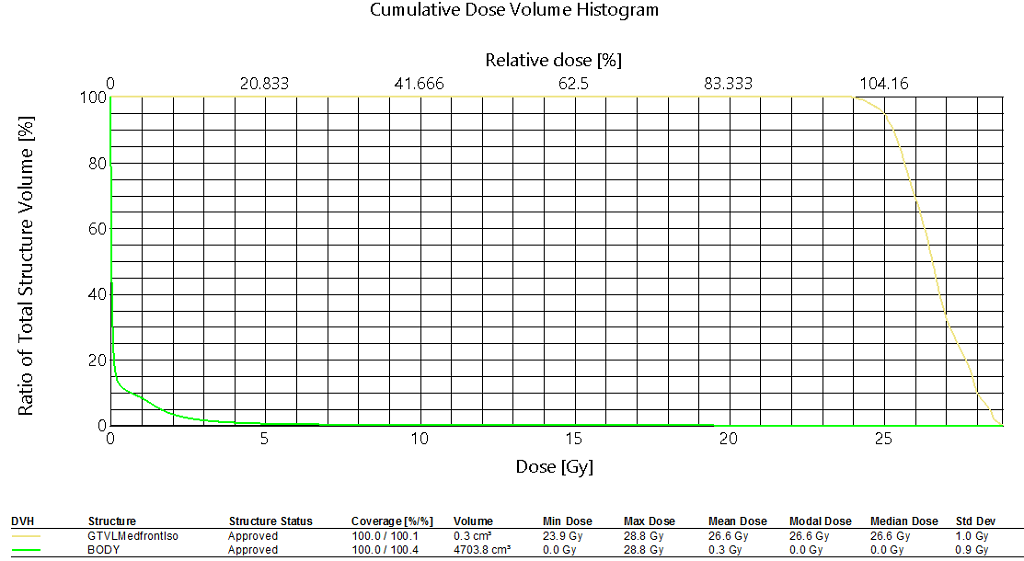Small single brain metastasis 24Gy
VMAT SX1
 |
Rx: 24Gy/1fx
Conformation/conformity test
9:11 VMAT treatment arc delivery time
 |
 |
 |
VMAT technique was chosen and six (6) almost complete arcs were used. Each arc used a different start and stop angle (offset by 1 degree) to stagger the available control points throughout each arc rotation. Thirty (30) degree separated collimator rotations were selected per arc and ordered for fastest treatment delivery (300, 330, 0, 30, 60, 90). Zero degree collimator arc rotations make sense on this machine because the two-stage, stacked and staggered MLC design significantly reduces interleaf leakage. One might assume, this VMAT SRS brain plan would be suboptimal overall due to the ratio of 1cm MLC leaf size versus target size (.75 cm in the transverse plan and 1.2cm head to foot -- .34cc total volume). However, using six (6) arcs, each with a unique collimator rotation, helped to reduce the impact of the larger 1cm leaves. In addition, the moderate 800MU/minute dose rate combined with MLC leaves that move twice as fast (5cm/sec) as previous designs (2.5cm/sec) result in a VMAT treatment delivery which can employ significantly more modulation. Given enough optimization time, Eclipse can create coplanar VMAT plans with a very impressive conformation number and volume receiving 50% of prescription dose even with very small target size (in this case). The “low dose bath” or volume of tissue receiving 2Gy is stretched in the transverse plane when compared to a non-coplanar arc delivery technique as is expected.
This case was optimized with the same optimization criteria on three different linac/MLC configurations in order to gauge a best case scenario for each. Those simple optimization criteria are seen here:
PTV: Upper 0% 30.0Gy Priority 50
Upper 0% 24.5Gy Priority 0 (used for NTO basis closer to Rx)
Lower 100% 24.5Gy Priority 150
NTO (manual):
Priority 140
Distance .13cm
Start 105%
End 45%
Fall-off .23
These settings were used and the plan was thoroughly optimized with the default 2.5mm optimization grid setting and the plan was then calculated with the default AAA 2.5mm grid size. Then, the optimizer was restarted continuing the previous optimization with current dose as intermediate dose but set to a 1.25mm (fine) grid size. After a final pause and once the cost-function line was flat again, the optimizer was un-paused and the plan was manually calculated a last time with AAA set to 1.25mm.
The completed treatment plan results for each MLC/machine results are as follows:
SX1 MLC (package C), 6XFFF, 6 coplanar arcs, 800MU/min, 6639 MU total
PTV coverage at 24Gy Rx = 99.7
24Gy Conformation Number = .65
24Gy Conformality Index = 1.52
12Gy Conformality Index = 15.8
M120 MLC, 6XFFF, 10 highly non-coplanar arcs, 1400MU/min, 8184 MU total
PTV coverage at 24Gy Rx = 99.7
24Gy Conformation Number = .55
24Gy Conformality Index = 1.8
12Gy Conformality Index = 12.9
HDMLC, 6XFFF, 10 highly non-coplanar arcs, 1400MU/min, 6858 MU total
PTV coverage at 24Gy Rx = 99.7
24Gy Conformation Number = .66
24Gy Conformality Index = 1.49
12Gy Conformality Index = 13.1[AM1]
Conformation number/conformality index ideal is 1.0 and the D50 (12Gy volume) is mostly a result of the coplanar vs. noncoplaner beam arrangements used
These numbers are very impressive, especially given the ratio of MLC leaf size to target size in this test. However, note that the 12Gy (50% dose) is slightly larger than would be expected superior and inferior to the target with a strictly coplanar beam arrangement. This result is likely an artifact of the 1cm leaves addressing a very small slightly irregular shape. The effect is not easily seen here due to the comparison to non-coplanar plans. But, this additional 50% dose superior and inferior to the target would be more obvious if compared to a coplanar HDMLC plan. With a coplanar HDMLC plan you would expect minimal inferior and superior dose.
This is a very high dose 24 Gy SRS plan. No OARs are used given the location of the target. Conformality is excellent. Dose fall off is adequate. Plan is clinically acceptable. Reasonable delivery time.
|
3rd party software plan report |
DICOM patient export |
Any reference to a "plan study" are simply what the organizers call each case and may not be a "study" in the FDA sense as they may not have been published in a peer reviewed journal.
Varian does not provide medical advice and these are illustrative examples only.
Leading plans by expert planner. Your results may vary.
FOR EDUCATIONAL AND SCIENTIFIC EXCHANGE ONLY – NOT FOR SALES OR PROMOTIONAL USE.